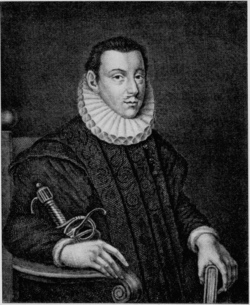James Crichton

James Crichton, known as the Admirable Crichton (19 August 1560 – 3 July 1582), was a Scottish polymath noted for his extraordinary accomplishments in languages, the arts, and sciences before he was killed at the age of 21.
Life
One of the most gifted individuals of the 16th century, James Crichton of Clunie (Perthshire; although some sources maintain his birthplace was Dumfries), was the son of Robert Crichton of Eliok, Lord Advocate of Scotland, and Elizabeth Stewart, from whose line James could claim Royal descent.
Educated at St Andrews University between the ages of ten to fourteen, during which time he completed requirements for both his bachelor's and master's degrees, James was taught by the celebrated Scottish scholar, politician and poet George Buchanan (1506–1582). It was apparent from his earliest days that James was an unusually gifted prodigy, which may have been associated with a gift for perfect recall. By the age of twenty, he was not only fluent in, but could discourse in (both prose and verse) no fewer than twelve languages, as well as being an accomplished horseman, fencer, singer, musician, orator, and debater. Noted for his good looks as well as his refined social graces, he was considered to have come closest to the ideal of the complete man.
Leaving Scotland, Crichton travelled to Paris, where he continued his education at the Collège de Navarre. It was in the French capital that he first came to prominence by challenging French professors to ask him any question on any science or liberal arts subject in Arabic, Dutch, English, French, Greek, Hebrew, Italian, Latin, Slavonic, Spanish, or Syriac. It is said that throughout the course of one extremely long day, French scholars failed to stump Crichton on any question they threw at him, no matter how abstruse.
Thereafter he spent two years as a soldier in the French army before travelling to Italy in 1579, winning acclaim in Genoa, Venice, and Padua by repeating his exploit of challenging Italian scholars to intellectual discourse and debate. Once, he is alleged to have bested a professional gladiator in a brutal fencing match.
In Venice in 1580, Crichton befriended the printer Aldus Manutius, who introduced him to the Venetian intellectual community, where the young Scot made an enormous impression on humanist scholars. In Padua in 1581, he clashed with a number of scholars over their interpretation of Aristotle, while demonstrating that their mathematics was flawed.
Perhaps tiring of intellectual duels, the following year Crichton entered the service of the Duke of Mantua, and may have become tutor to the Duke's headstrong son Vincenzo Gonzaga (although some sources suggest that Crichton served only as a member of the ducal council, and did not actually teach the prince).
What is beyond dispute is that while Crichton was in the Duke's employ, Vincenzo Gonzaga became hugely jealous of him, probably from a combination of his father's strong regard for the young prodigy as well as Crichton replacing Vincenzo as the lover of the prince's former mistress.
On the night of 3 July 1582, after leaving this lady's dwelling in Mantua, Crichton was attacked in the street by a gang of masked ruffians. He bested all but one with his sword, until the last man removed his mask to reveal the group's ringleader, Vincenzo Gonzaga himself. Tradition holds that, on seeing Vincenzo, Crichton instantly dropped to one knee and presented his sword, hilt first, to the prince, his master's son. Vincenzo took the blade and with it stabbed Crichton cruelly through the heart, killing him instantly. James Crichton of Cluny was then in his twenty-second year.
Reputation
Much of Crichton's posthumous reputation comes from a romantic 1652 account of his life written by Sir Thomas Urquhart (1611–1660), contained within an unclassifiable work (The Jewel) that is characterized by exaggeration and hyperbole. There is little or no contemporary evidence for many of the stories surrounding him.[1] That said, his existence is supported by a few letters and his actual abilities were probably impressive. A historical novel entitled Crichton was published by the English writer William Harrison Ainsworth in 1836. "The Admirable Crichton" is referred to by Charles Dickens in his 1859 story collection The Haunted House. The "Admirable Crichton" was mentioned as an exemplar in W. M. Thackeray's Vanity Fair (1847) and referenced in chapter 3 of Anthony Trollope's The Prime Minister (1876). James Crichton's sobriquet was later employed by fellow Scot Sir James Barrie as the title of his 1902 satirical play, The Admirable Crichton, about a butler whose savoir-faire far exceeds that of his aristocratic employers. A memorial to Crichton can be found in the church of St Bride's in Sanquhar and in the church of San Simone in Mantua.
He is also the namesake of the James Crichton Society[2] at St Andrews University which publishes a monthly academic journal.
Sources
References
Further reading
- Sir Thomas Urquhart, The Discovery of a Most Exquisite Jewel (1652)
- Francis Douglas, Life of James Crichton of Clunie (1760)
- Tytler, Patrick Fraser (1819), Life of James Crichton of Cluny, Commonly Called the Admirable Crichton (1st ed.), Edinburgh: William and Charles Tait, retrieved 28 October 2013
- William Harrison Ainsworth, Crichton (1836)
- Douglas Galbraith, Crichton (2011)
- David Wallechinsky and Irving Wallace, The People's Almanac (1975–81)
 This article incorporates text from a publication now in the public domain: Chisholm, Hugh, ed. (1911). "Crichton, James". Encyclopædia Britannica. 7 (11th ed.). Cambridge University Press. pp. 434–435.
This article incorporates text from a publication now in the public domain: Chisholm, Hugh, ed. (1911). "Crichton, James". Encyclopædia Britannica. 7 (11th ed.). Cambridge University Press. pp. 434–435.